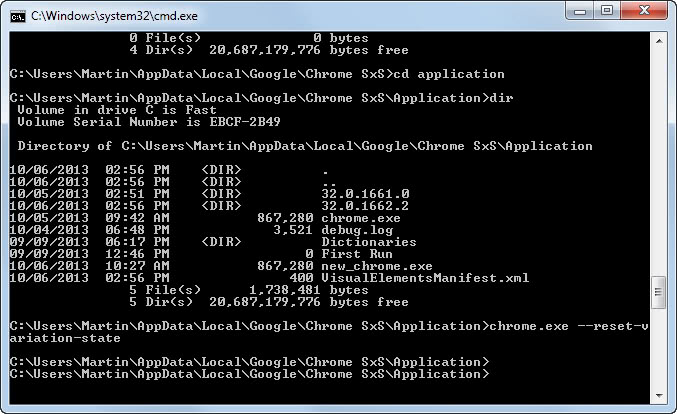
Chrome supports hundreds of different command line switches that may add features to the browser, change how features work, or remove features from it.
Some switches are only useful to developers, as they enable them to test certain features in Chrome, while others have practical uses that users of the web browser will appreciate as well.
The following list highlights important Chrome command line switches for users of the browser.
Before that, I'd like to walk you through the configuration process that explains how you can add one or multiple command line switches to the Chrome browser.
Note: The guide explains how this is done on Windows only.
Adding command line switches to Chrome
You have two main options to do so. First, you can open the Windows command line, change the directory to the Chrome directory, and run commands using chrome.exe followed by the commands that you want to run. An example would be the following command executed in the Chrome application directory on the system.
chrome.exe --reset-variation-state
The easiest way to do so is the following way:
This is great for testing purposes, but if you like a certain command and want to run it at all times, you may want to make those changes permanent so that they are automatically used whenever you load Chrome.
If you are starting Google Chrome from a shortcut, placed on the desktop, taskbar or start menu, then you can easily add command line switches to it. Just right-click the shortcut, locate Google Chrome there, right-click on it and select Properties.
The Shortcut tab should open up automatically. It displays the load path of the browser in the target field. At the end of the field, after the closing ", add a space, and then the command line switches you want to use.
Add another space between each command line switch if you want to use multiple ones.
| Command | Description |
| --ash-force-desktop | Forces uses of the desktop version of Chrome |
| --disable-3d-apis | Disables 3D Apis, including WebGL and Pepper 3D |
| --disable-accelerated-video | Disables GPU accelerated video |
| --disable-background-mode | Background apps won't continue to run when Chrome exits. |
| --disable-gpu | Disables hardware acceleration using the GPU |
| --disable-plugins | Prevents all plugins from running |
| --disable-plugins-discovery | Disables the discovery of missing plugins |
| --disable-preconnect | Disables speculative TCP/IP preconnections |
| --disable-translate | Disables the Google Translate feature |
| --dns-prefetch-disable | Disable DNS prefetching |
| --enable-kiosk-mode | Kiosk Mode for Chrome OS |
| --incognito | Launches Chrome directly in Incognito private browsing mode |
| --media-cache-size | Disk space used by media cache in bytes |
| --multi-profiles | Enable multiple profiles in Chrome |
| --new-profile-management | Enable the new profile management in Chrome |
| --no-experiments | Run Chrome without experiments set in chrome://flags |
| --no-pings | No hyperlink auditing pings |
| --no-referrers | Use Chrome without sending referrers |
| --purge-memory-button | Add purge memory button to Chrome |
| --reset-variation-state | Change the field trials that the browser is currently signed up for |
| --restore-last-session | Restore the last session on run |
| --ssl-version-min | Specify the minimum SSL version accepted |
| --start-maximized | Starts the Chrome window maximized. |
| --window-position | Specify the initial window position using --window-position=x,y |
| --window-size | Specify the initial window size using --window-position=x,y |
For a full list of switches, consult this page.